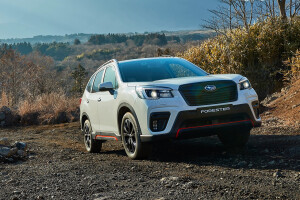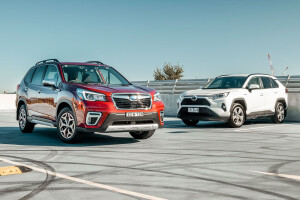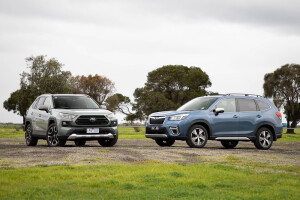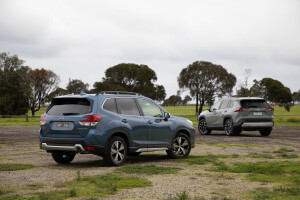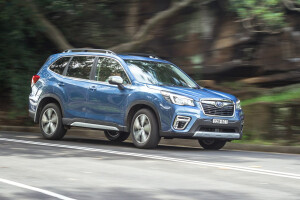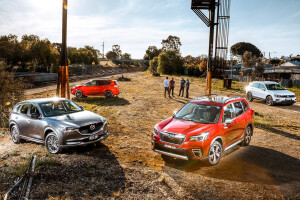The Subaru Forester was introduced in 1997 and the SUV quickly became known for its balance of practicality and car-like driveability, coupled with genuine off-road ability.
During its lifetime, several performance models have been offered such as the second-generation Forester’s turbocharged XT and the third-generation Forester’s S-Edition, which used a turbocharged version of the 2.5-litre flat-four to produce 193kW.
Now in its fifth generation, the model is available with a choice of 2.5-litre boxer four-cylinder petrol engine or a 2.0-litre version combined with a mild hybrid system.
All are offered with the company’s renowned symmetrical all-wheel drive system and a continuously variable transmission (CVT) auto.
The Forester is Australia’s favourite Subaru and, in its current generation, was runner up in the 2018 Wheels Car of the Year.
The Subaru Forester can count plenty of rivals, such as the Hyundai Tucson, Kia Sportage, Mazda CX-5, Toyota RAV4, and Volkswagen Tiguan.
Latest Review
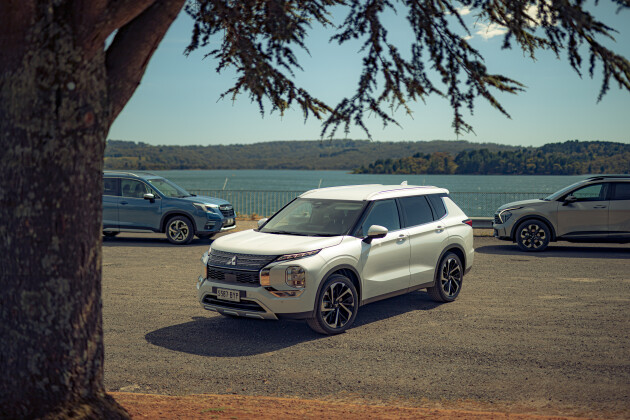
2022 Mitsubishi Outlander v Kia Sportage v Subaru Forester comparison review
Mitsu is out to stake a claim with its all-new Outlander, but Kia’s fresh Sportage and the updated Subaru Forester are deeply ensconced on the mid-size SUV reservation
If you’re buying a new car in Australia and don’t want a dual-cab ute, chances are you’re after a mid-size SUV. It’s the second-biggest-selling segment locally with 17 percent of the market as of November 2021 and as a consequence, it’s raining new models.
Two of the highest profile appearances have been the Mitsubishi Outlander and the Kia Sportage but we not only need to compare them to each other, but also an established benchmark.
That benchmark is the Toyota RAV4, both because it’s a very polished performer in its latest incarnation and also the dominant sales force. However, that popularity is both a blessing and a curse, with COVID-related supply and production issues stretching wait lists out to six months. If you’re after an all-wheel drive hybrid, as we would be here, that wait could stretch out to 10 months.
Given the RAV4’s supply situation and the fact it’s largely a known quantity, instead we turn to another Aussie favourite, the Subaru Forester, which itself has recently had a mid-life refresh for the 2022 model year. It’s not just a nip and a tuck, either.
Yes, there are revisions to the headlights, fog lights, front bumper and grille. But further to that, Lane Departure Prevention, Lane Centring and Autonomous Emergency Steering have been added to the Subaru’s EyeSight active safety suite, while the suspension features retuned springs and dampers.
Our test car is the $44,190 2.5i-S, which pairs the 139kW/239Nm 2.5-litre naturally-aspirated boxer-four engine with the highest specification level. Therefore it’s packed to the gills with equipment, including all manner of collision avoidance and mitigation systems, a driver monitoring system to ensure you remain focused on the task at hand, auto lights and wipers, dual-zone climate control, a panoramic sunroof, electric tailgate, heated eight-way adjustable electric seats, leather trim, an eight-speaker Harman Kardon stereo, DAB radio, smartphone mirroring, native sat-nav and more.
It also comes with a five-year/unlimited-kilometre warranty, though servicing is required every 12 months/12,500km, Subaru’s capped price servicing setting you back a total of $2422.38 over those five years.
That’s expensive when you consider that servicing our second contender, the Mitsubishi Outlander Aspire, over the same duration costs just $995 and the total for 10 years is $3190, with the final service accounting for $799 of that.
Mitsubishi also offers 10 years of warranty coverage, which is dependent on you servicing at an official dealer, with the intervals being every 12 months or 15,000km.
The $43,990 Aspire is a newcomer to the Outlander range and is the entry-level ‘fancy’ variant. To clear up that confusing statement, while there are lower variants in the range, the Aspire is the cheapest to score the likes of 20-inch wheels, a 12.3-inch digital driver display, 10.8-inch head-up display and powered and heated front seats.
These little luxuries enhance what is a fairly substantial standard spec list. It largely mirrors the Forester, though wireless phone charging and Apple CarPlay are worthwhile additions and it does without a sunroof.
The Sportage, on the other hand, trumps both, but then so it should because we have the wrong variant here. Kia Australia is still waiting for its mid-spec Sportages so we grabbed a GT-Line instead which costs $49,370RRP or $51,990 driveaway.
Kia’s warranty is an impressive seven years/unlimited kilometres and servicing will cost you a hefty $2465 over the first five years and $3988 over the first seven, though these figures are yet to be finalised at the time of writing.
The reason we feel comfortable using the range-topper is that aside from a few trinkets it’s identical to the SX+ which, when fitted with the 1.6-litre turbocharged engine required to add all-wheel drive, costs $43,500 – absolutely bang on compared to our assembled rivals. As is the equipment list, which again is very similar: heated and powered seats, full active safety suite, power tailgate, eight-speaker Harman Kardon audio, smartphone mirroring, etc.
However, this spec disparity does require that we don’t get distracted by this range-topping Sportage’s toys – no easy feat when your first impression on entering Kia’s new mid-sizer is the panoramic curved screen that incorporates a pair of high-resolution 12.3-inch displays.
We also need to ignore the sunroof, leather seats with suede upper, memory driver’s seat, LED interior lighting, wireless phone charging, ventilated front seats, shift-by-wire rotary gear selector nicked from the Genesis GV70 and the blind-spot view monitor from the same, which displays the side of the car in the digital instruments when the indicator is engaged.
‘We’, in this case, are myself and Wheels News Editor Kat Fisk, who not only has a keen eye, but as the mum of a toddler, brings both a different and very relevant perspective on how the interiors of these three SUVs stack up. Her thoughts are incorporated here.
There is still plenty to like aboard the Sportage. Its infotainment is easily navigated, though it shares the Kia quirk of having wireless charging but no wireless CarPlay. What’s particularly flash is the switchable panel that alternates between menu and climate control at the touch of a button. Clever.
Device inputs include a USB-C and A port in the front and a pair of USB-C ports in the rear incorporated into the front seats. The front headrests are also cleverly designed, sculpted to accept either a coat hanger or, more commonly, to hang an iPad for the entertainment of the little ’uns in the back.
There’s plenty of room in the reclinable 60:40 split back row and the 543L boot, though material quality isn’t class leading, with hard plastics on some obvious surfaces, and the door bottle holders are too small.
No such problems in the Outlander, with all doors able to accommodate one-litre bottles, but the rest of the interior is a frustrating mix of highs and lows. Material quality is fantastic, with most surfaces covered with plush leather padding, the seats are comfortable, there’s slick wireless smartphone charging and mirroring – though also a USB-A and C front and rear.
Meanwhile the Aspire’s piano black centre console doesn’t reflect sunlight like the Exceed’s silver finish, and the second row is both reclinable and adjustable fore and aft.
Trouble is, what should be the Outlander’s trump card – its third row of seats – only creates compromise. That third row eats into boot space, is basically useless for carrying occupants as there’s no room for a child seat and anyone old enough to not need one won’t fit.
Further, the Outlander’s second row room also suffers compared to the others, though Kat finds its seat material does keep a child seat more stable. There is still a decent amount of space in the rear and boot, though just not as much as its rivals, and the Mitsubishi is the only car here with a space-saver spare rather than a full-size wheel.
The older Forester can’t match the Sportage and Outlander for showroom pizzazz, but it counters with intelligent design features such as rear doors that open almost to 90 degrees and masses of room. Kat finds that even with a child seat installed she can walk through the rear which makes accessing ISOFIX or adjusting straps and the like so much easier.
The combination of the sunroof and massive windows lets in plenty of light yet there’s still almost a comical amount of space, particularly headroom, and the boot can swallow 498L of gear.
It does lack the premium feel of its newer competitors, though. All the equipment is present but the infotainment screen is much smaller and Subaru’s split-screen arrangement is slightly strange. It’s also a busy interior with plenty of dials and buttons, but both Kat and I agree that it’s not such a bad thing, with most functions a mere press away rather than swiping through multiple screens.
The Forester does love to beep at you, though; occasionally with good reason if your eyes wander from the road, sometimes by being overzealous with its lane-keep assist, an affliction the Sportage shares.
On the road the Forester continues to impress. Its ride quality is pleasingly pliant, almost plush, yet without excessive body motion. The CVT still has a little of that dreaded ‘rubber band’ feeling but in regular driving feels just natural enough to avoid irritation.
Selecting ‘S’ on the drive mode selector definitely perks up the throttle response, the regular ‘I’ mode standing not so much for intelligent as insipid. Subaru claims 7.4L/100km for combined use but don’t be surprised if it nudges up towards 10L in a city environment, though all three of our contestants are happy with regular 91RON.
At more enthusiastic speeds the Forester hangs on gamely, providing a level of entertainment beyond what it really needs to possess. Turn-in is a little slow but grip levels and balance are impressive, revealing a chassis of genuine talent. Flicked into manual mode the CVT auto finds eight ‘virtual’ ratios in its continuously variable spread and quickly changes between them should the driver use the steering wheel paddles.
Unfortunately, the boxer engine’s reserves of grunt aren’t deep. Its throttle is clearly mapped to provide most of the power in the first half of its range so while it feels adequate in most day-to-day scenarios, flooring the accelerator results in little extra urge.
The performance star of this trio is the Kia Sportage. Its 132kW/265Nm are similar to the Subaru and Mitsubishi and its 1.6-litre engine is by far the smallest, but the addition of a turbocharger lends it a handy torque advantage.
Peak twist is delivered from just 1500rpm compared to 3600rpm for the Outlander and 4400rpm for the Forester which makes for far more relaxed progress. A proper seven-speed dual-clutch gearbox also helps, though it can be slow to downshift in response to extra throttle.
While the extra torque is useful, it’s still not the most pleasant engine, sounding coarse when revved and upshifting automatically at just 5500rpm. Unlike its rivals here, though, the Sportage offers a range of engine options, including a front-drive 2.0-litre petrol ($2000 cheaper) for those who aren’t in a hurry and a 137kW/416Nm diesel that asks for an extra $3000.
Not only does it offer more power, but it’ll stretch the Sportage’s relatively meagre 54-litre fuel tank a bit further, too, Kia claiming combined consumption of 6.3L/100km versus 7.2L for the 1.6T.
The Sportage’s chassis shines brighter than its powertrain. Like the Subaru the ride is excellent, though occasionally slightly nibbly over smaller bumps, but Kia’s local chassis gurus have done fine work in balancing comfort and dynamics.
The Sportage turns in more keenly than the Forester, retains excellent body control and impressively resists falling into the understeer that plagues less adepts SUVs. Like the Subaru there’s a surprising level of enjoyment to be found driving the Kia with verve, even if few buyers are ever likely to feel the need to.
But when it comes to having a punt, it’s the Outlander that’s possibly the pick, which goes to show just what a massive improvement this latest-generation model is over its predecessor. Accurate, well-weighted steering, a balanced – and even mildly adjustable – chassis and relatively strong grip make it not just capable but even fun on the right road.
Select Tarmac on the drive mode selector and, like the Forester, the Outlander’s CVT does an impressive impersonation of a slick eight-speed automatic, even when left to its own devices.
However, like the Forester, the 2.5-litre naturally-aspirated four-cylinder engine in the nose of the Mitsubishi struggles to provide meaningful performance beyond urban trundling. Part of the reason for this is that at 1725kg, the Outlander is 82kg heavier than the Sportage and a substantial 149kg more than the Forester.
Evidence of this is the comparatively thirsty 8.1L/100km combined claim, though in Mitsubishi’s defence it’s a figure that seems readily achievable in the real world and thus more or less on par with its competitors.
Unfortunately, where the Outlander trips up is an area where the Sportage and Forester shine – ride quality. Its damping is nice enough, but on poor surfaces the ride becomes brittle and fidgety, constantly feeding road imperfections back to the occupants, which can quickly get tiresome in a family cruiser.
Perhaps going down a rung to the LS and its 18-inch wheels would help, but we haven’t yet driven this variant to confirm. It’s a shame, because in so many other ways the Outlander is a likeable and capable SUV.
All three are, in fact, and you can’t really go wrong with any of them, but it’s the Outlander that falls out of consideration first. It’s still definitely worth a test drive, especially if you’re a fan of the bold looks, but its two biggest shortcomings are in arguably the most important areas for a mid-size SUV: comfort and practicality.
The ride hampers the former and the borderline unusable third row does the latter no favours. It does claw back plenty of margin, though, with its cheap servicing and fantastic warranty offering.
Nudged into second position is the Forester, but it remains a fine choice in the segment. It’s safe, comfortable, has heaps of room, plenty of equipment, handles well and while its interior won’t have any jaws dropping, it’s functional and practical.
Its biggest problem is under the bonnet, the atmo boxer excelling in neither performance nor economy. Not a deal-breaker, but enough for it to be bumped from the top spot on the podium.
The Sportage’s powertrain is also its weakest link, but that’s as much a reflection on the excellence of the rest of the package as it is the lack of character and occasional gearbox stumble. Kia’s latest offering is sharply styled, has a finely tuned chassis, lots of space, a fresh, modern interior, lengthy warranty and the price is about right, too.
Quibbles are relatively minor: a bit less hard plastic on the inside, the fuel tank is a little small and the brakes feel a bit grainy underfoot. The biggest issue facing the Sportage buyer is waiting for the SX+ to land on Australian shores and not being tempted by the show-stopping GT-Line...
Live with front-wheel drive, pocket the savings
We’d argue that the Sportage SX+ and Outlander Aspire variants are the sweet spots in their respective ranges in terms of balancing price and specification, but if you’re happy to forgo all-wheel drive you’ll save a handy $2500 on the Outlander and improve fuel economy, while the front-drive Sportage costs $2000 less but also reverts to an underwhelming 2.0-litre naturally-aspirated four-cylinder engine.
Subaru’s all-wheel drive ethos means there’s no front-drive Forester, but lose a couple of toys and the 2.5i Premium is good value at $41,140, a $3050 saving.
SCORING
Kia Sportage: 8.0/10
Subaru Forester: 8.0/10
Mitsubishi Outlander: 7.5/10
News
-
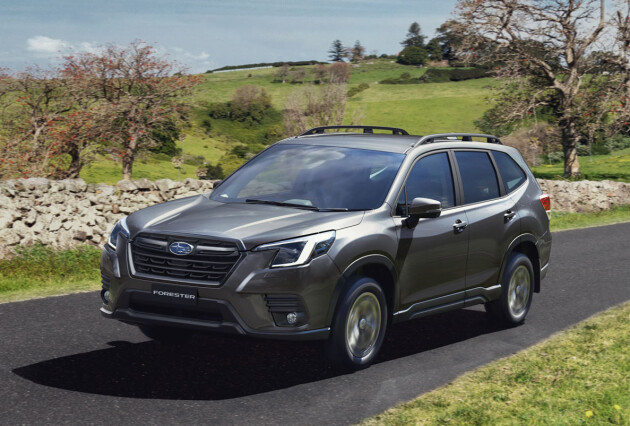 News
News2023 Subaru Forester 2.5X Special Edition announced, here before Christmas
The entry-level Subaru Forester receives an aftermarket infotainment system in a bid to reduce wait times
-
 News
News2023 Subaru Forester STI Sport revealed for Japan, Australian launch unlikely
Subaru Tecnica International is keeping busy despite the lack of a WRX STI
-
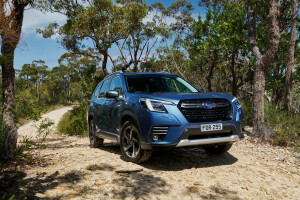 News
News2023 Subaru Forester on sale in Australia ahead of fourth quarter launch
The updated Subaru Forester comes at a premium ahead of its arrival later this year
-
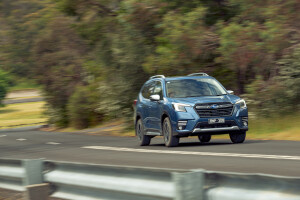 News
News2022 Subaru Forester sold out in Australia, MY23 arriving soon
Allocated stock of the Forester has been accounted for, with Subaru asking customers to instead enquire about the forthcoming MY23 version
-
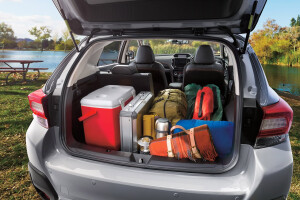
Boot sizes of Australia’s favourite SUVs
-
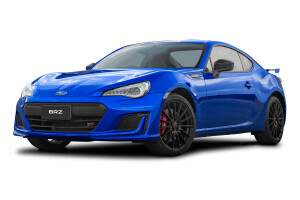
Subaru recalls range of 2018-2019 models over fuel pump fault
-
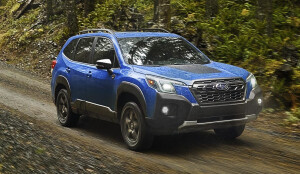
Subaru Forester Wilderness revealed on Canadian website
-
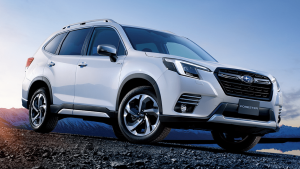
2022 Subaru Forester pricing and features revealed



